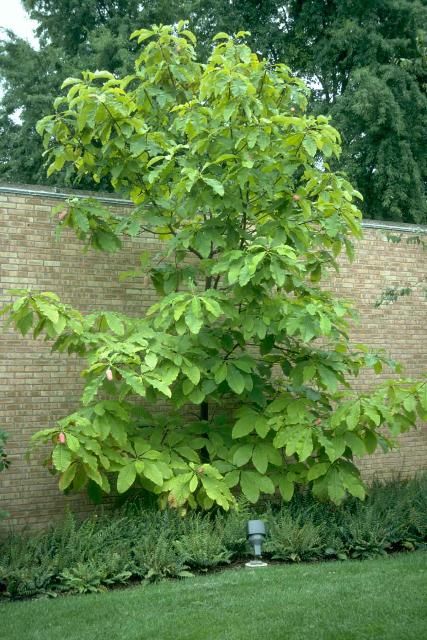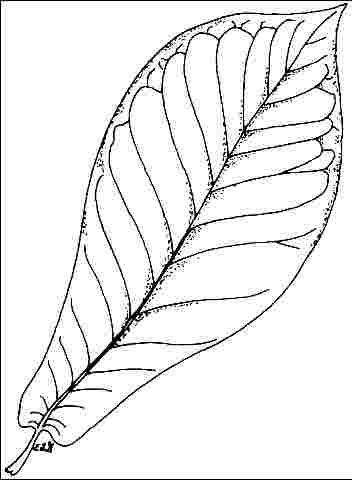Introduction
This North American native tree is deciduous in most areas but semi-evergreen in the Deep South. Bigleaf Magnolia grows slowly to 30 to 40 feet and spreads 20 to 25 feet forming a rounded, broad canopy. The leaves of Bigleaf Magnolia are truly large, 12 to 32 inches long and 7 to 12 inches wide, when found in the wild and somewhat smaller when grown in landscapes. These leaves are bright green above with a fuzzy, silver/grey underside, creating a beautiful, two-toned effect with each passing breeze. From May to July the showy, fragrant blossoms appear, each 8 to 12-inch-wide, ivory-colored bloom having a slight rose tint at its base. These blooms are followed by the production of 2.5 to 3-inch-long, hairy, red, egg-shaped fruits. Bigleaf Magnolia trees must be 12 to 15-years-of-age before they begin to bloom.

Credit: Ed Gilman
General Information
Scientific name: Magnolia macrophylla
Pronunciation: mag-NO-lee-uh mack-roe-FILL-uh
Common name(s): Bigleaf Magnolia
Family: Magnoliaceae
USDA hardiness zones: 5B through 8B (Fig. 2)
Origin: native to North America
Invasive potential: little invasive potential
Uses: specimen; shade
Availability: somewhat available, may have to go out of the region to find the tree

Description
Height: 30 to 40 feet
Spread: 20 to 30 feet
Crown uniformity: irregular
Crown shape: oval
Crown density: moderate
Growth rate: moderate
Texture: coarse
Foliage
Leaf arrangement: alternate (Fig. 3)
Leaf type: simple
Leaf margin: entire
Leaf shape: oblong, obovate
Leaf venation: pinnate, brachidodrome
Leaf type and persistence: deciduous
Leaf blade length: 12 to 18 inches, 18 to 36 inches
Leaf color: green
Fall color: no color change
Fall characteristic: not showy

Flower
Flower color: white/cream/gray
Flower characteristics: very showy
Fruit
Fruit shape: elongated
Fruit length: 1 to 3 inches
Fruit covering: dry or hard
Fruit color: red
Fruit characteristics: attracts birds; showy; fruit/leaves a litter problem
Trunk and Branches
Trunk/bark/branches: branches droop; not showy; typically one trunk; thorns
Pruning requirement: little required
Breakage: resistant
Current year twig color: brown, green
Current year twig thickness: thick
Wood specific gravity: unknown
Culture
Light requirement: full sun, partial sun or partial shade
Soil tolerances: clay; sand; loam; acidic; slightly alkaline; well-drained
Drought tolerance: moderate
Aerosol salt tolerance: unknown
Other
Roots: not a problem
Winter interest: no
Outstanding tree: no
Ozone sensitivity: tolerant
Verticillium wilt susceptibility: susceptible
Pest resistance: resistant to pests/diseases
Use and Management
The tree may be rather short lived in many landscape sites unless its cultural requirements are met fairly closely. Branches break easily in wind storms and ice-laden branches snap off. The large leaves decompose slowly after they fall and blow around on the ground creating litter which some people will find objectionable. It may be best to locate this tree in a ground cover bed where leaves can drop and filter down beneath the low growing plants unseen.
Bigleaf Magnolia should be grown in full sun or partial shade on well-drained soil, and does not tolerate wet soil or drought. It appears to be somewhat picky in its requirements. In its native habitat it is found on rich, moist soils.
Cultivars include `Palmberg', with very large flowers, and `Purple Spotted', flowers with purple markings in the center.
Propagation is by seed or softwood cuttings.
Pests and Diseases
No pests or diseases are of major concern.